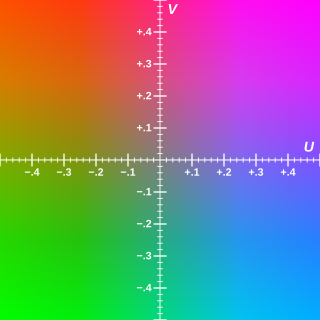
Y′UV, also written YUV, is the color model found in the PAL analogue color TV standard. A color is described as a Y′ component (luma) and two chroma components U and V. The prime symbol (') denotes that the luma is calculated from gamma-corrected RGB input and that it is different from true luminance. Today, the term YUV is commonly used in the computer industry to describe colorspaces that are encoded using YCbCr.

HSL and HSV are the two most common cylindrical-coordinate representations of points in an RGB color model. The two representations rearrange the geometry of RGB in an attempt to be more intuitive and perceptually relevant than the cartesian (cube) representation. Developed in the 1970s for computer graphics applications, HSL and HSV are used today in color pickers, in image editing software, and less commonly in image analysis and computer vision.

The CIELAB color space, also referred to as L*a*b*, is a color space defined by the International Commission on Illumination in 1976. It expresses color as three values: L* for perceptual lightness and a* and b* for the four unique colors of human vision: red, green, blue and yellow. CIELAB was intended as a perceptually uniform space, where a given numerical change corresponds to a similar perceived change in color. While the LAB space is not truly perceptually uniform, it nevertheless is useful in industry for detecting small differences in color.

YCbCr, Y′CbCr, or Y Pb/Cb Pr/Cr, also written as YCBCR or Y′CBCR, is a family of color spaces used as a part of the color image pipeline in video and digital photography systems. Y′ is the luma component and CB and CR are the blue-difference and red-difference chroma components. Y′ is distinguished from Y, which is luminance, meaning that light intensity is nonlinearly encoded based on gamma corrected RGB primaries.
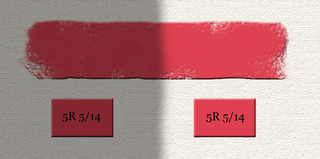
Colorfulness, chroma and saturation are attributes of perceived color relating to chromatic intensity. As defined formally by the International Commission on Illumination (CIE) they respectively describe three different aspects of chromatic intensity, but the terms are often used loosely and interchangeably in contexts where these aspects are not clearly distinguished. The precise meanings of the terms vary by what other functions they are dependent on.
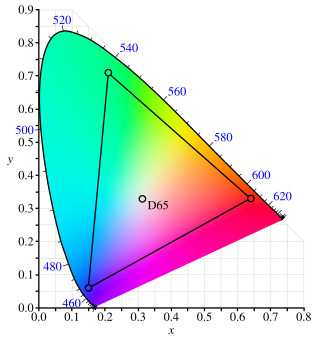
The Adobe RGB (1998) color space or opRGB is a color space developed by Adobe Inc. in 1998. It was designed to encompass most of the colors achievable on CMYK color printers, but by using RGB primary colors on a device such as a computer display. The Adobe RGB (1998) color space encompasses roughly 30% of the visible colors specified by the CIELAB color space – improving upon the gamut of the sRGB color space, primarily in cyan-green hues. It was subsequently standardized by the IEC as IEC 61966-2-5:1999 with a name opRGB and is used in HDMI.
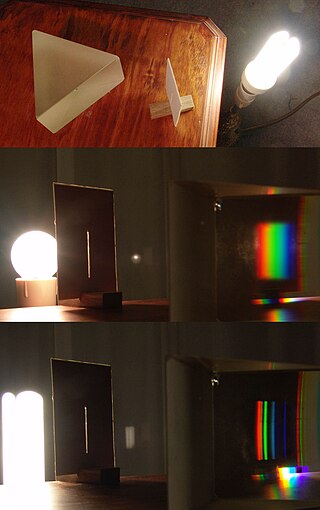
A color rendering index (CRI) is a quantitative measure of the ability of a light source to reveal the colors of various objects faithfully in comparison with a natural or standard light source.
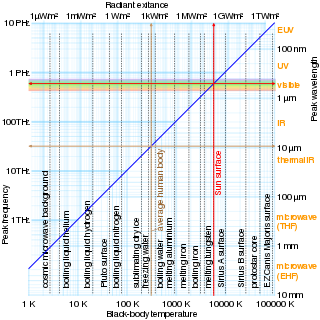
Correlated color temperature refers to the temperature of a Planckian radiator whose perceived color most closely resembles that of a given stimulus at the same brightness and under specified viewing conditions."

In 1931 the International Commission on Illumination (CIE) published the CIE 1931 color spaces which define the relationship between the visible spectrum and the visual sensation of specific colors by human color vision. The CIE color spaces are mathematical models that create a "standard observer", which attempts to predict the perception of unique hues of color. These color spaces are essential tools that provide the foundation for measuring color for industry, including inks, dyes, and paints, illumination, color imaging, etc. The CIE color spaces contributed to the development of color television, the creation of instruments for maintaining consistent color in manufacturing processes, and other methods of color management.

LMS, is a color space which represents the response of the three types of cones of the human eye, named for their responsivity (sensitivity) peaks at long, medium, and short wavelengths.
Relative luminance follows the photometric definition of luminance including spectral weighting for human vision, but while luminance is a measure of light in units such as , relative luminance values are normalized as 0.0 to 1.0, with 1.0 being a theoretical perfect reflector of 100% reference white. Like the photometric definition, it is related to the luminous flux density in a particular direction, which is radiant flux density weighted by the luminous efficiency function of the CIE Standard Observer.

A standard illuminant is a theoretical source of visible light with a spectral power distribution that is published. Standard illuminants provide a basis for comparing images or colors recorded under different lighting.
In statistics, the Kendall rank correlation coefficient, commonly referred to as Kendall's τ coefficient, is a statistic used to measure the ordinal association between two measured quantities. A τ test is a non-parametric hypothesis test for statistical dependence based on the τ coefficient. It is a measure of rank correlation: the similarity of the orderings of the data when ranked by each of the quantities. It is named after Maurice Kendall, who developed it in 1938, though Gustav Fechner had proposed a similar measure in the context of time series in 1897.
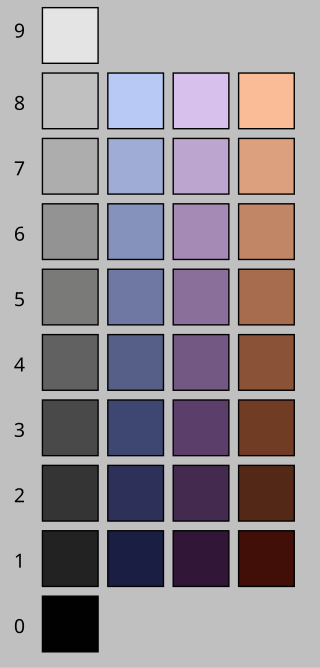
Lightness is a visual perception of the luminance of an object. It is often judged relative to a similarly lit object. In colorimetry and color appearance models, lightness is a prediction of how an illuminated color will appear to a standard observer. While luminance is a linear measurement of light, lightness is a linear prediction of the human perception of that light.
In colorimetry, the CIE 1976L*, u*, v*color space, commonly known by its abbreviation CIELUV, is a color space adopted by the International Commission on Illumination (CIE) in 1976, as a simple-to-compute transformation of the 1931 CIE XYZ color space, but which attempted perceptual uniformity. It is extensively used for applications such as computer graphics which deal with colored lights. Although additive mixtures of different colored lights will fall on a line in CIELUV's uniform chromaticity diagram, such additive mixtures will not, contrary to popular belief, fall along a line in the CIELUV color space unless the mixtures are constant in lightness.

The CIE 1960 color space ("CIE 1960 UCS", variously expanded Uniform Color Space, Uniform Color Scale, Uniform Chromaticity Scale, Uniform Chromaticity Space) is another name for the (u, v) chromaticity space devised by David MacAdam.
A color appearance model (CAM) is a mathematical model that seeks to describe the perceptual aspects of human color vision, i.e. viewing conditions under which the appearance of a color does not tally with the corresponding physical measurement of the stimulus source.

ICTCP, ICtCp, or ITP is a color representation format specified in the Rec. ITU-R BT.2100 standard that is used as a part of the color image pipeline in video and digital photography systems for high dynamic range (HDR) and wide color gamut (WCG) imagery. It was developed by Dolby Laboratories from the IPT color space by Ebner and Fairchild. The format is derived from an associated RGB color space by a coordinate transformation that includes two matrix transformations and an intermediate nonlinear transfer function that is informally known as gamma pre-correction. The transformation produces three signals called I, CT, and CP. The ICTCP transformation can be used with RGB signals derived from either the perceptual quantizer (PQ) or hybrid log–gamma (HLG) nonlinearity functions, but is most commonly associated with the PQ function.
Hunter Lab is a color space defined in 1948 by Richard S. Hunter. It was designed to be computed via simple formulas from the CIEXYZ space, but to be more perceptually uniform. Hunter named his coordinates L, a and b. Hunter Lab was a precursor to CIELAB, created in 1976 by the International Commission on Illumination (CIE), which named the coordinates for CIELAB as L*, a*, b* to distinguish them from Hunter's coordinates.

The Oklab color space is a uniform color space for device independent color designed to improve perceptual uniformity, hue and lightness prediction, color blending, and usability while ensuring numerical stability and ease of implementation. Introduced by Björn Ottosson in December 2020, Oklab and its cylindrical counterpart, Oklch, have been included in the CSS Color Level 4 and Level 5 drafts for device-independent web colors since December 2021. They are supported by recent versions of major web browsers and allow the specification of wide-gamut P3 colors.









































